Illustrated Review: Examining Sidney Crosby's adeptness at creating space
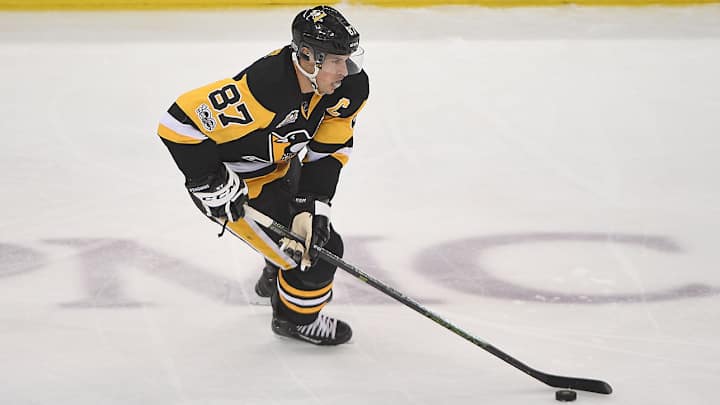
Sidney Crosby, during an age of hockey that has seen plenty of star power, has been the NHL's top player for quite some time. He's been the best hockey player since the time of Wayne Gretzky, who is the NHL's greatest player ever.
There have been descending arguments and convoluted narratives, but those are alternative facts. On Thursday, the Pittsburgh Penguins center became the 86th player to reach the 1,000-point milestone with an assist against the Winnipeg Jets.
Eleven players reached 1,000 points in fewer career games than Crosby, and the list is, of course, full of NHL legends: Mario Lemieux, Mike Bossy, Peter Stastny, Jari Kurri, Guy Lafleur, Bryan Trottier, Denis Savard, Steve Yzerman, Marcel Dionne, Phil Esposito and yes, Gretzky.
Penguins forward Sidney Crosby notches 1,000th NHL point
And Crosby will continue to climb the ranks. He won't remain the league's 86th-highest scorer for long. The question is just how low on the list he will end up.
But in this season that will honor and analyze and recognize Crosby for his greatness, the NHL's consummate playmaker (no one has more assists per game than Crosby since he entered the league in 2005) has rediscovered a scoring touch the likes of which he hasn't shown since 2010.
The Penguins captain is no goal-scoring slouch: His rate of nearly a half a goal per game ranks fourth among all skaters since 2005. The guys on the list ahead of him—Alex Ovechkin, Steven Stamkos and Ilya Kovalchuk—are bona fide goal scorers. And then there's Crosby, who doesn't carry that reputation, which is partially why eyebrows are raised when he's pacing the Rocket Richard race in mid-February.
Crosby has cooled off since an absolutely torrid start that saw him score 21 goals in his first 23 games, and 26 in his first 31. Goal Scorer Sidney Crosby peaked in 2010, before he was injured in the 2011 Winter Classic. Consider that prior to that setback, Crosby went through a stretch where he scored 83 goals in 110 regular season games.
During the 2009-10 season Crosby scored 1.68 goals per 60 minutes at even strength, according to Stats.HockeyAnalysis.com. Then the next season that mark jumped to 2.01. His goal scoring was on the rise. Ovechkin has never scored at such a rate at even strength. This was an unparalleled stretch in the dead-puck era.
Though he hasn't returned to those towering rates, Crosby will likely churn out his second 40-plus goal season of his career in 2017. Another one of those 21-in-23 type stretches could get him to 50, with a shooter's chance to possibly set a new career mark, and surpass the 51 he scored in 09-10, 'shooter' being the key word.
Illustrated Review: Breaking down the Los Angeles Kings' overtime success
When Crosby was lighting the world on fire, it was his wrist and snap shots striking the side of the matchbox. NHL.com catalogues how many kinds of shots a player takes, and how many goals he scores on said shots. According to that data, 27 of Crosby's 51 goals in 09-10 were scored via wrist shots, and another eight via snap shots, each career highs for a single season.
Then, next season, seven of the 32 goals Crosby scored prior to his injury (or 21.88 percent) were via snap shots. There's some subjectivity to qualifying what is a wrist or snap shot, but what's clear is, when Crosby was scoring goals by the barrel load, they weren't coming via one-timers.
Now looking at his splits from this season, it's again lots of wrist and snap shots. His wrist shot has accounted for 47.40 percent of all of his shots, which would be the second highest mark for his career. The season he used his wrist shot most was also the season when he scored on it the most, in 09-10, when it accounted for 50.34 percent of all his shots, and scored 18.12 percent of the time.
Then there's the snap shot: He's scoring on it at a rate of 26.92 percent this season, which would shatter the 21.88 percent he shot on them in 2010-11, in that half season before he got injured, when he was at his scoring height.
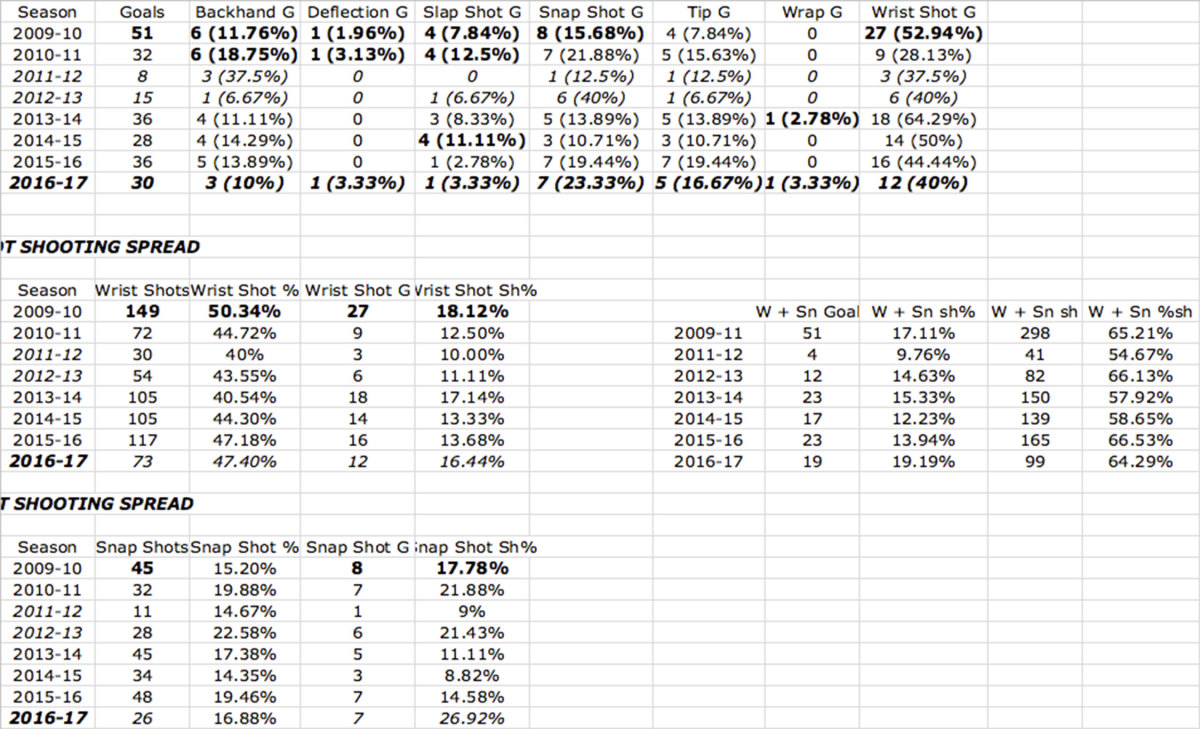
• W +Sn goals = Combined wrist and snap shot goals
• W +Sn sh% = Combined wrist and snap shot shooting percentage
• W + sn sh = Combined wrist and snap shots
• W + sn %sh = Combined wrist and shape shot percentage of shots (the percent his combined wrist and snap shots account for his total shots)
So to connect some dots, when Crosby was at his goal-scoring best he was taking a high number of wrist and snap shots. Now he's attempting and scoring them again at rates approaching his previous stratosphere.
That Crosby might be tweaking his shot selection is one theory, but the driving force behind any player's ability to shoot is space on the ice. Crosby and the Penguins have done a great job of finding him some real estate, which has gone a long way into his scoring rejuvenation.
Floating In Anonymity
Goal scorers have this innate ability to find space despite the attention they command. Ovechkin is always open at the "Ovechkin spot"; Stamkos seems to always find just enough time and space to snap a perfect shot.
One of the things Crosby does very well is play off the positioning of his teammates. He processes the game a few megabits faster than everyone else in the league, and then choreographs or ad libs what he sees into an efficient sequence.
When the Penguins hit the blue line, it's a familiar looking zone entry for a 3-on-2. Crosby, flanked out wide, is giving Cameron Gaunce a target. Gaunce has the ability to play the puck wide, and then drive to the net, bringing the Flyers defensemen with him, and leaving space behind him for a trailer to sneak down and take a pass from Crosby.
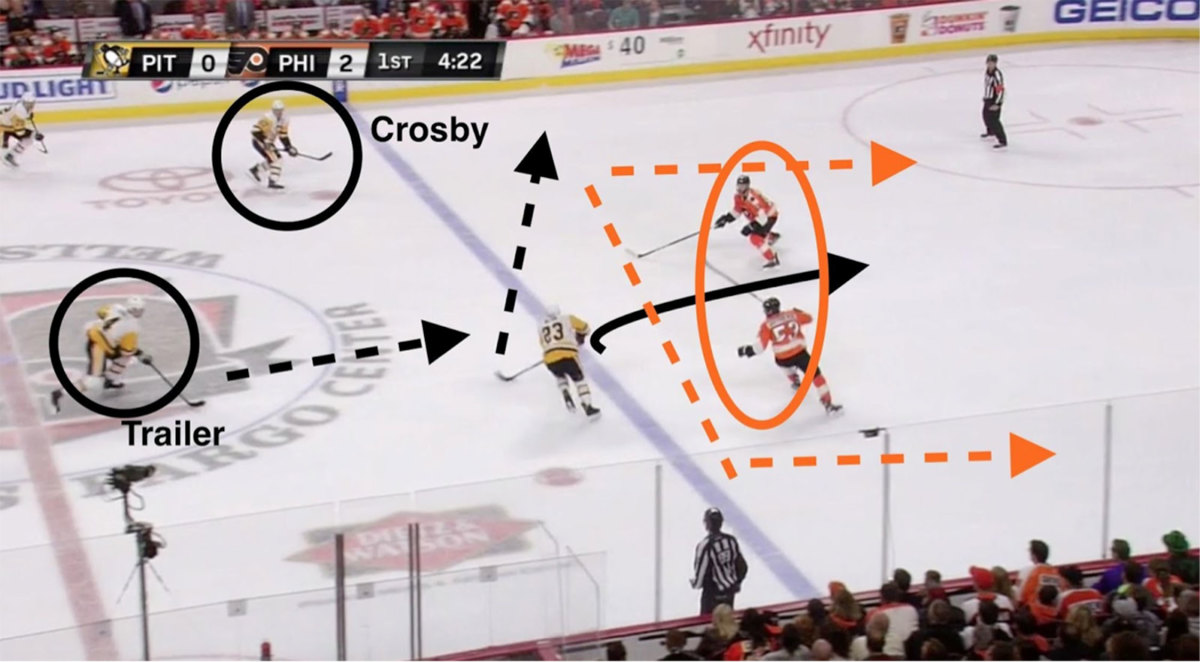
Now that Crosby has the puck, the wheels are in motion. Gaunce can drive the center lane, opening space up for defenseman Justin Schultz to rotate above the circles in a good position to shoot.
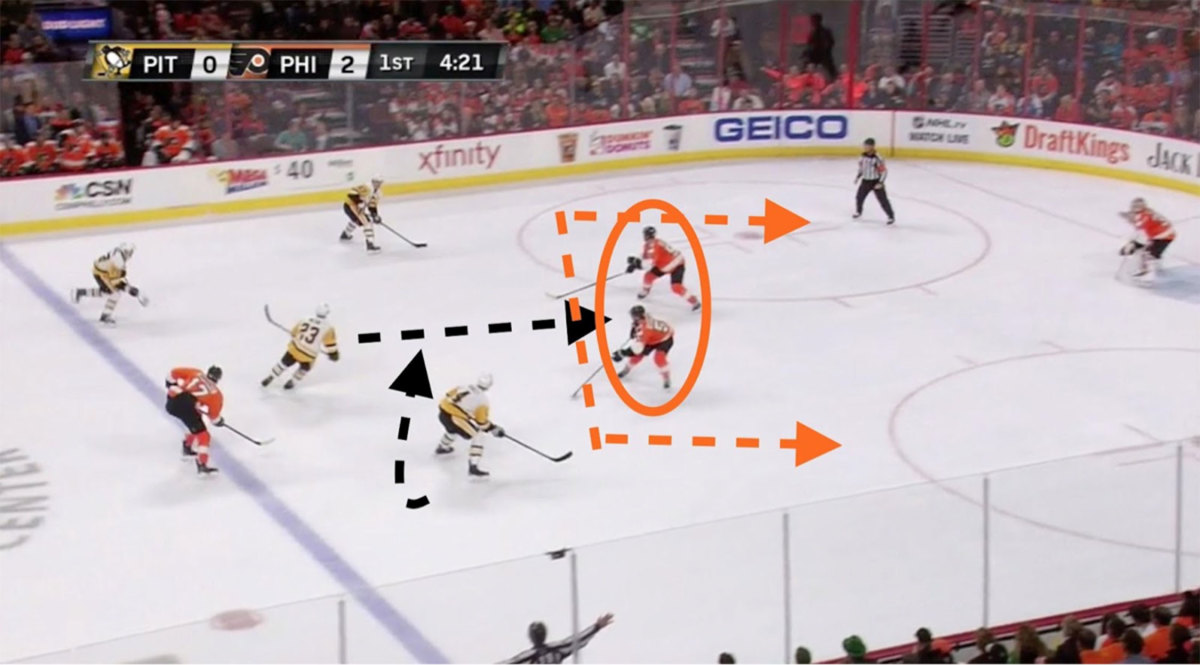
But if Crosby is anything, he's not predictable. He carries the puck an extra second, shifting everyone lower in the zone. He plays the puck back to Patric Hornqvist, the second trailer, while he maintains his wide position.
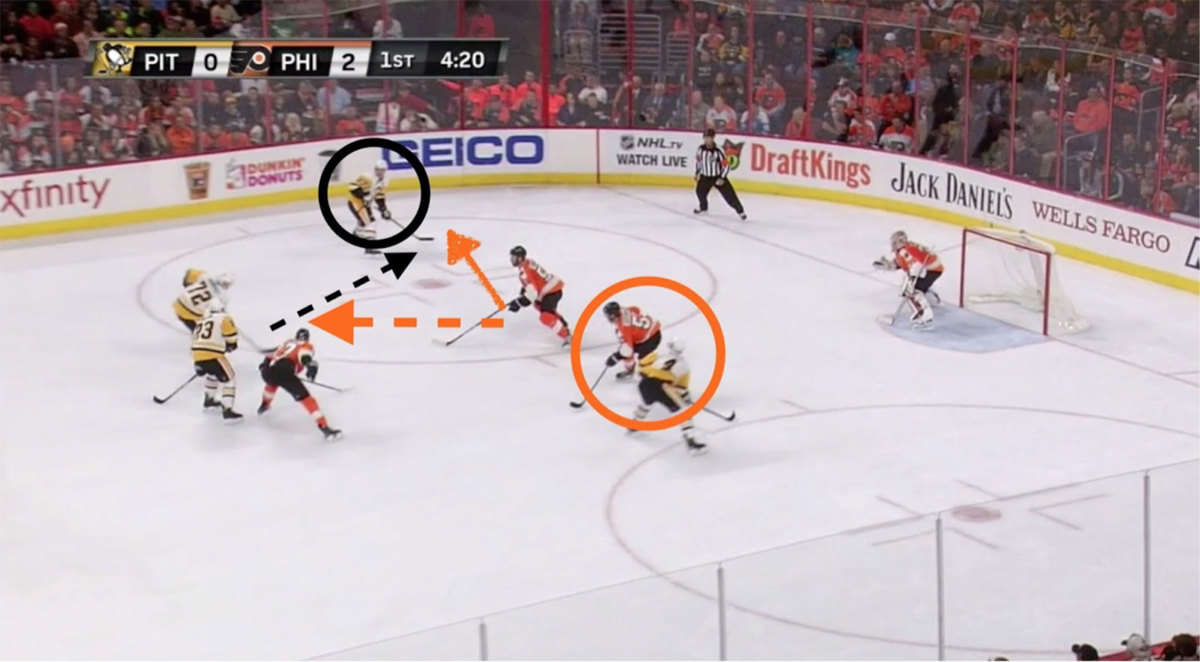
Flyers defenseman Nick Schultz knows he's supposed to stay with Crosby. When Schultz entered the locker room that morning, odds are that '87' was written on the whiteboard, and circled. Schultz's eyes tell a similar story.
But by using Hornqvist, Crosby forces Schultz to take a different route. Schultz has to pull up and try to make a play on Hornqvist, while Crosby continues ahead, taking a return pass from Hornqvist.
This leaves Crosby with time and space from an off-angle, which can often be enough for the Penguins captain.
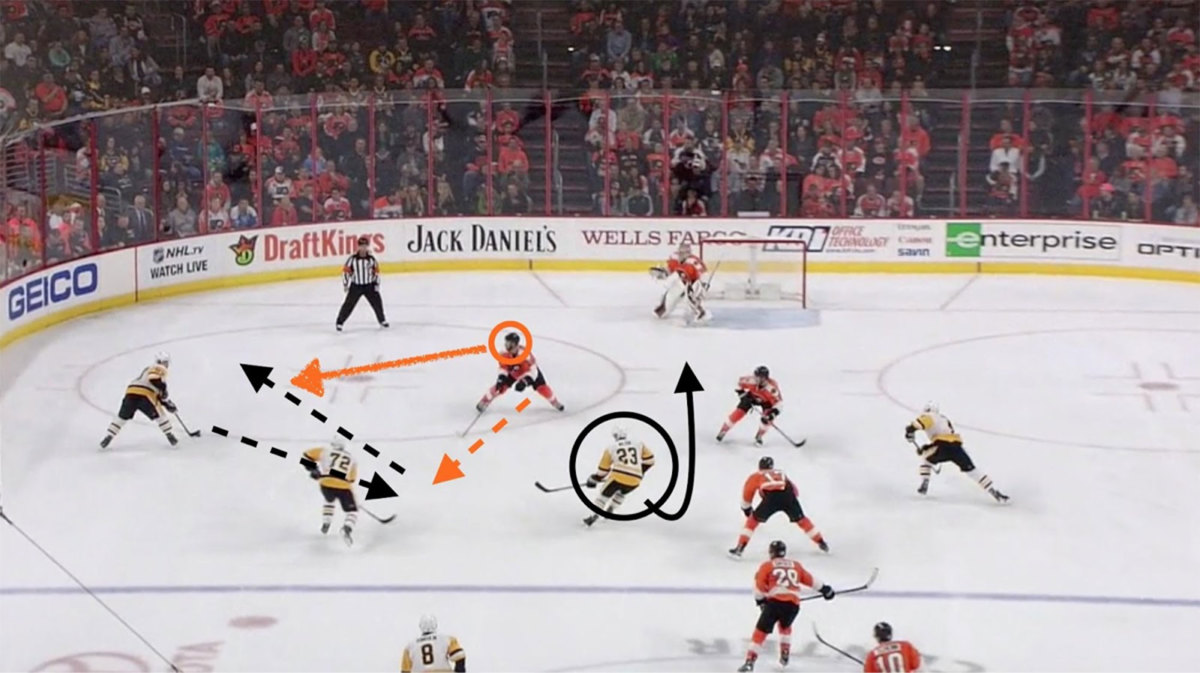
Skaters know they're not supposed to leave Crosby; he's part of the film session and game plan every time he's in the lineup. But Crosby has become so deft at using his teammates like slaloms in the offensive zone, forcing his opponents to navigate them.
It's akin to a really good shooter in basketball. After the ball (or puck) is released, the shooter can move around his teammates, looking for an unoccupied spot on the three-point line to settle.
Crosby can't take advantage of picks, but he can use the space his teammates are entitled to, and work around that to create natural picks. It's a concept Mike Babcock long employed for the Detroit Red Wings.
This starts with a similar zone entry. Crosby is out wide, with two Carolina Hurricanes defensemen back. Tom Kuhnhackl can drive toward the crease, carrying the defensemen with him, and Bryan Rust should be able to flash across the zone and play the role of trailer.
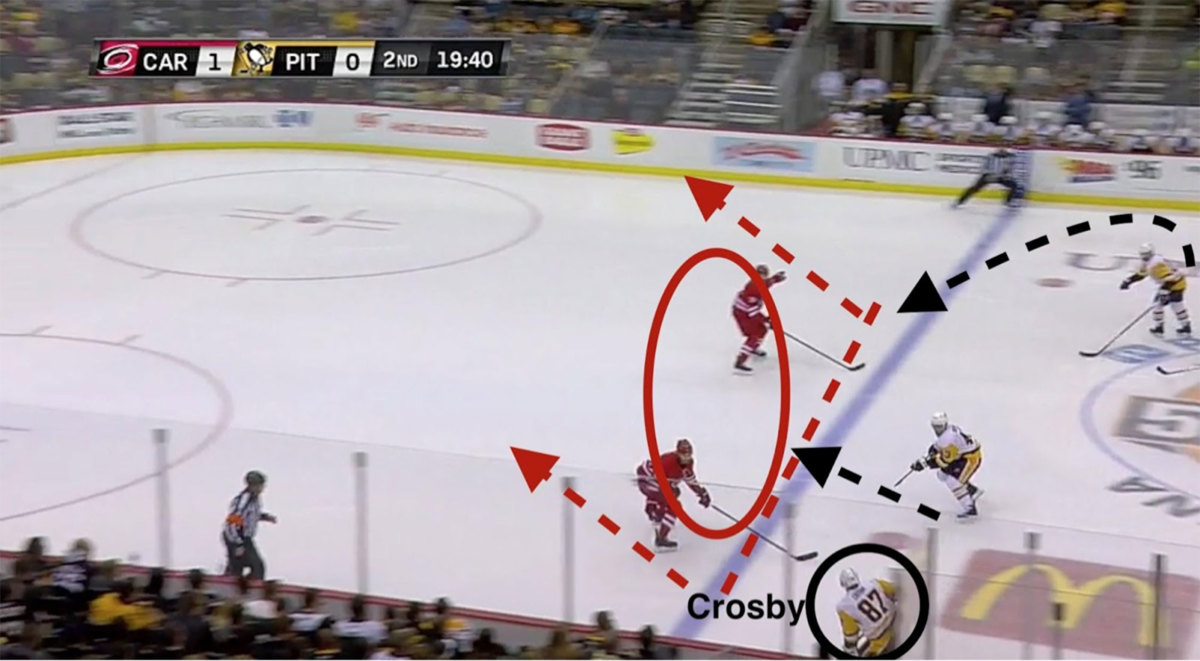
Crosby though decides to initiate the action a different way. Knowing Kunhackl is creating space, Crosby will skate the puck to the center of the zone. On the far side, Rust is carrying a back-checking forward down with him, and blueliner Jacob Slavin has to continue to backpedal. Way behind the play is Schultz, who will end up being instrumental.
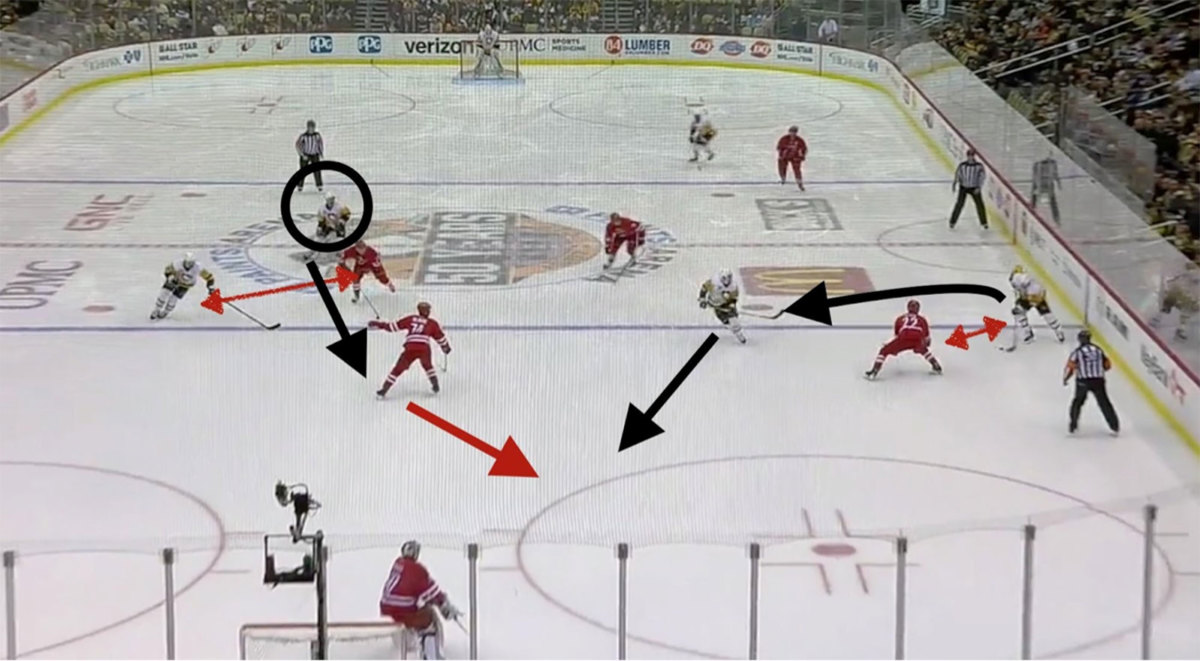
At this point, Crosby is freelancing. There's a pocket of space in the high slot that Crosby wants to occupy; it's just a matter of how to get there. Hurricanes defenseman Brett Pesce pulls up to check Crosby. Elias Lindholm, the back-checking forward, gets completely turned around.
This is part of the in-zone chasing Crosby uses to find space. By leaving the puck and interchanging spots with Schultz, Lindhold has to through two bodies to follow Crosby. Lindholm has to turn and face the play, meaning by the time Crosby gets to his spot, with Lindholm's momentum carrying him toward the goal, Crosby just bought himself some time.
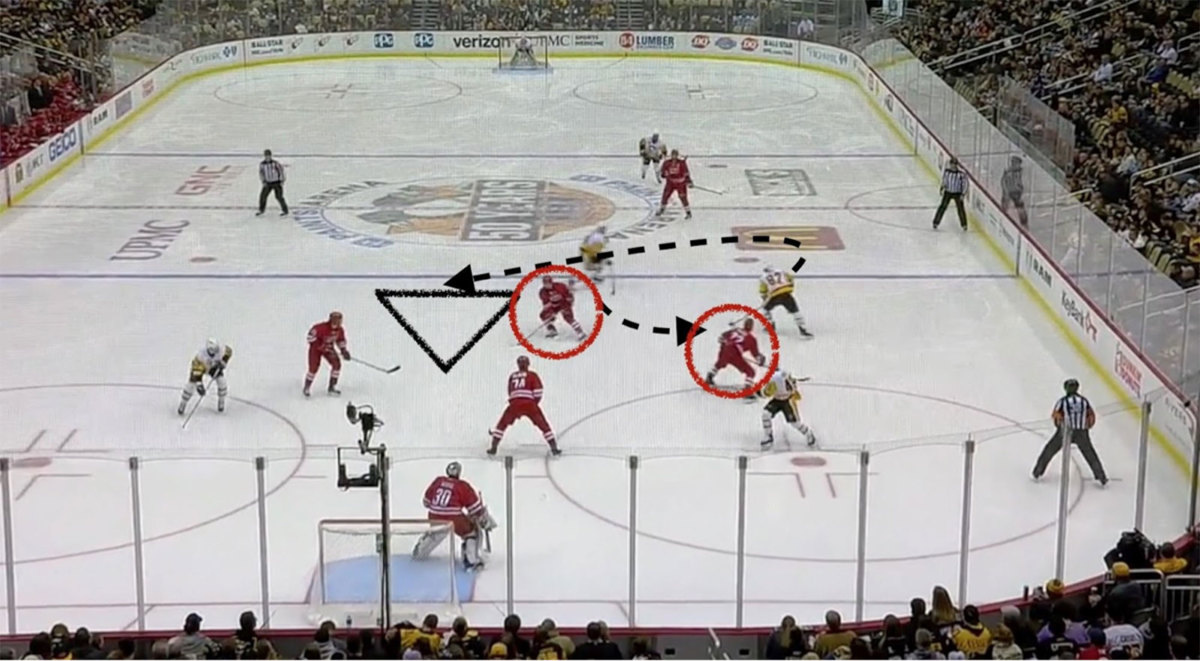
These aren't significant gaps, but Pesce isn't close enough to Schultz to play the passing lane, and Lindholm isn't close enough to Crosby to prevent him from getting off a quick shot. And, again, a quick shot is all Crosby really need.
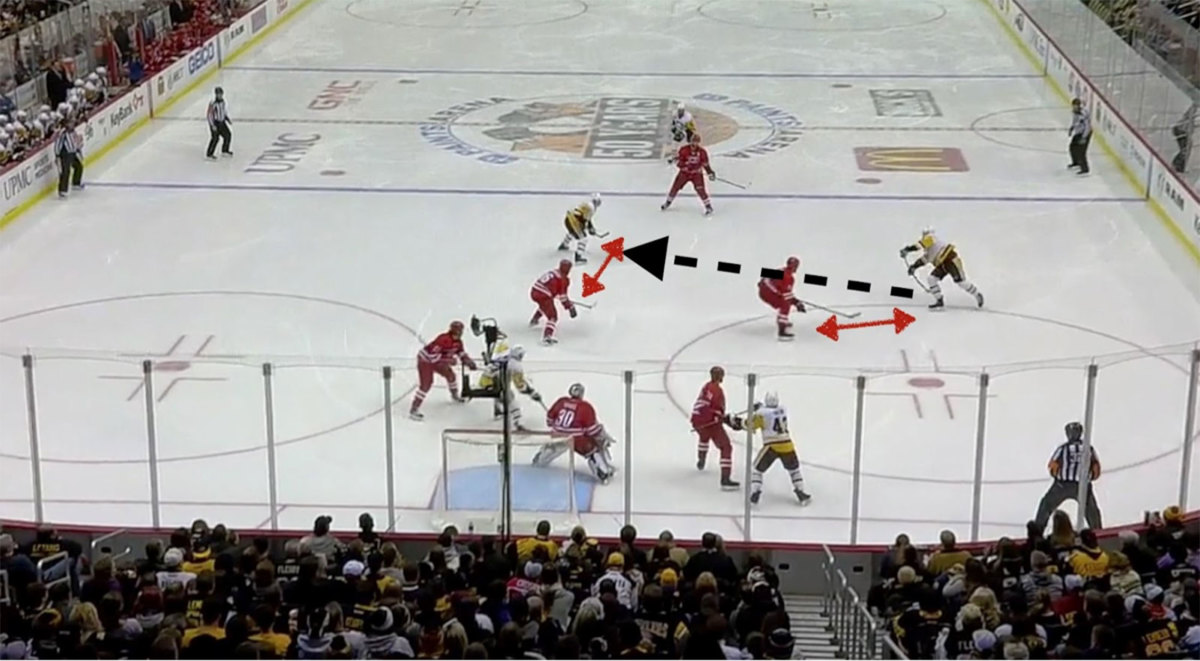
Crosby demands the attention of his opponents every time he hops over the boards, and from there, it's a chess match. Teams have been gameplanning and accounting for Crosby for the past decade-plus, while Crosby and the Penguins have found ways to counter those measures with their own moves.
This season, Crosby has been scoring on a greater percentage of his wrist and snap shots, the shot-type that has led to his most goals throughout his career. Part of what has facilitated that, and has allowed him to take those shots at a higher rate, is how he's played off his teammates into relatively anonymous spacing, despite being one of the best players the NHL has ever seen.
